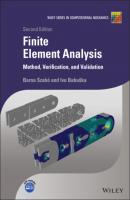Finite Element Analysis. Barna Szabó
Чтение книги онлайн.

Читать онлайн книгу Finite Element Analysis - Barna Szabó страница 30
Название: Finite Element Analysis
Автор: Barna Szabó
Издательство: John Wiley & Sons Limited
Жанр: Физика
isbn: 9781119426462
isbn:
as indicated in Fig. 1.6. When Dirichlet boundary condition is prescribed on only one of the boundary points then this expression is modified to include the term corresponding to that point only.
On substituting eq. (1.80) into eq. (1.79) the second term on the right‐hand side of eq. (1.79) can be written as
where Nu is the number of unconstrained equations, that is, the number of equations prior to enforcement of the Dirichlet boundary conditions. (For instance, in Example 1.6
Figure 1.6 Recommended choice of the function
Since
Remark 1.7 In order to avoid having to renumber the coefficient matrix once the rows and columns corresponding to φK and φL were eliminated, all elements in the Kth and Lth rows and columns can be set to zero, with the exception of the diagonal elements, which are set to unity. The corresponding elements on the right hand side vector are set to û0 and ûℓ. This is illustrated by the following example.
Example 1.7 Consider the problem
the exact solution of which is
Using five elements of equal length on the interval
Referring to equations (1.66) and (1.70), the element‐level coefficient matrix for each element is
where we used
Upon enforcement of the Dirichlet conditions the system of equations is